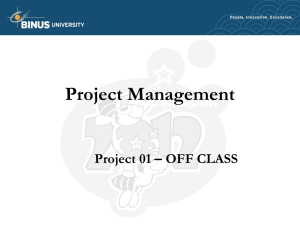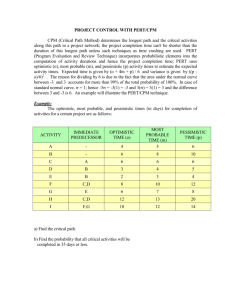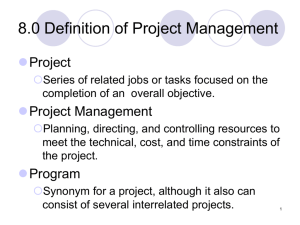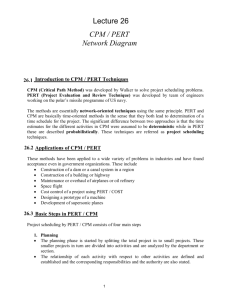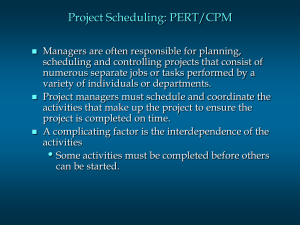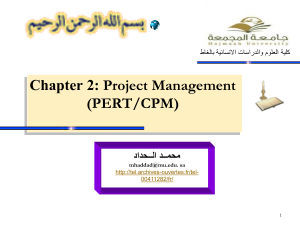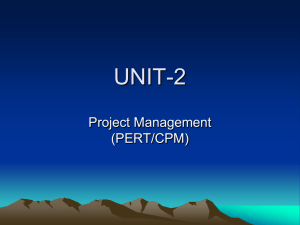Project Management
advertisement
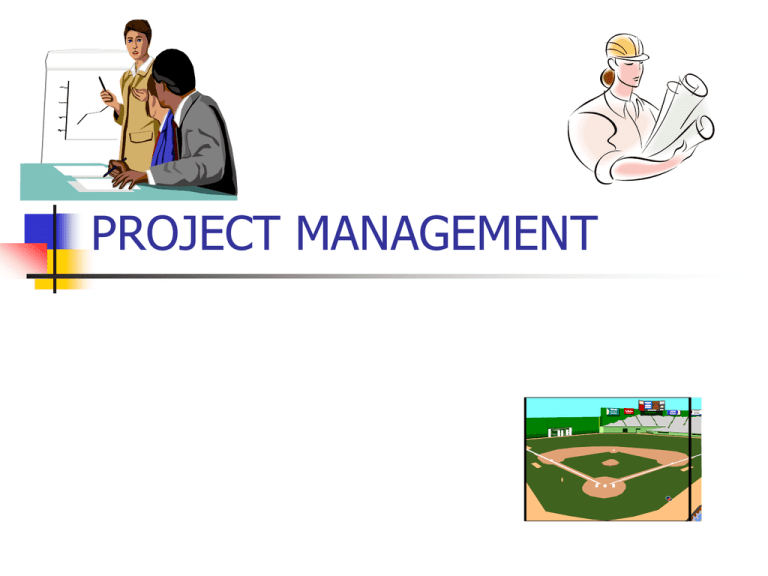
PROJECT MANAGEMENT Outline What is a “project”? Project Management Objectives and tradeoffs Planning and Control in Projects Scheduling Methods Constant-Time Networks PERT and CPM Methods Use of Project Concepts What is a “Project”? A project is a series of related jobs directed towards some major output and requiring a significant period of time to perform. Distinguishing characteristics of projects Examples – New product introduction Installation of Equipment What is “project management”? Project management can be defined as planning, directing, and controlling resources (i.e., people, equipment, material) to meet the technical, cost and time constraints of the project. Examples Building construction Designing an advertising campaign Research and development Startup and shutdown of a plant Computer systems design Manufacturing of aircraft, ships or large machines Fund raising Planning a military invasion Objectives and tradeoffs Three objectives:CostsSum of direct and allocated costs Schedule – Project milestones and completion dates are set at the outset. Meet them or trade-off between costs Performance – the performance characteristics of the product or service. Trade-off may also be required here. Objectives and Tradeoffs Due Date! Stay within the budget Meet the deadline Meet the specifications Project Management Activities and Decisions Planning Scheduling Project Planning Identify the project customer Establish the end product or service Set project objectives Estimate total resources and time required Decide on the form of project organization Make key personnel appointments Define major tasks required Establish a budget Scheduling Develop a detailed work breakdown structure Estimate time required for each task Sequence the task in the proper order Develop a start/stop time for each task Develop a detailed budget for each task Assign people to tasks Control Monitor actual time, cost, and performance Compare planned to actual figures Determine whether corrective action is needed Evaluate alternative corrective actions Take appropriate corrective action Scheduling Methods Two main types of scheduling methods are in use. They are generally classified as 1. Gantt charts 2. Network Methods a. CPM b. PERT Gantt Chart Project Example (Figure 1) Week 1 2 3 4 5 6 7 1 0 / 2 1 1 0 / 2 8 1 1 / 4 1 1 / 1 1 1 1 / 1 8 1 1 / 2 5 1 2 / 2 D i g b a s e m e n t P o u r f o o t i n g L a y b l o c k F i n i s h b a s e w o r k I n s t a l l m a i n f l o o r E r e c t f r a m e S e c u r e s h e a t h i n g I n s t a l l r o o f b o a r d s I n s t a l l w i n d o w s F i n i s h f r a m e s A c t i v i t y M i l e s t o n e Network Methods-1 CPM – Critical Path Method Developed by E.I. Duponds & Co as a way to schedule the startup and shutdown of major plants. Plant activities were repeated often so activity times were fairly well known. CPM uses time-cost trade-off. Four estimates for each activity are used: normal time, normal cost, crash time and crash cost Network Methods-2 PERT-Program Evaluation and Review Technique First developed in the mid 1950’s for the Polaris submarine project. It was used to schedule 3000 subcontractors, suppliers and agencies. It is credited with bringing that project ahead of schedule by up to two years. PERT PERT requires three time estimates for each activity: optimistic time estimate most likely time estimate pessimistic time estimate These estimates recognize the uncertainty in activity time for real life situations PERT Activity times are converted to expected time of completion and variance for each activity Network Project Chart (Figure 2) 7 1 2 3 5 6 Dig basement Pour footing Lay block foundation Install main floor Erect frame Start 4 Secure outside sheathing 8 Install roof 10 boards Finish belowgrade work 9 Install windows Finish rough-in frame Constant-Time Networks Activity times assumed to be constant “Dummy” activities – Duration time of 0 and are sometimes needed to indicate precedence relationships only in drawing networks Notations used in calculating start and finish times: ES(a) = Early Start of activity a EF(a) = Early Finish of activity a LS(a) = Late Start of activity a LF(a) = Late Finish of activity a Network Diagram (Figure 3) 2 5 3 2 1 4 1 Event Activity 4 6 3 Dummy Activity Situations (Figure 4a) E F H G a. Activities F and G have the same predecessor (E) and the same successor (H) Dummy Activity Situations (Figure 4b) C A E B D b. Activity A and B have a common predecessor (E), but they also have different predecessors (C and D) Dummy Activity Situations (Figure 4c) I C K D J c. Activities C and D have a common successor (K), but also have different successors (I and J) Calculating ES, EF, LS, LF, and Completion Time Forward Pass: ES (a) = 0 for the starting activity EF (a) = ES (a) + t (a)* ES (a) = max [EF (all predecessors of a)] Project completion time = max [EF(all ending activities)] Backward pass: LF (a) = min [LS (all successors of a)] LS (a) = LF - t(a)* * t (a) denotes the duration of activity a Forward and Backward Passes Information from computations on the networks are used for several managerial purposes. 1. critical path identification 2. slack times calculation 3. Determination of final completion date of project CRTTICAL PATH The critical path is the longest time path through the project network It determines project completion Activities on the critical path are carefully monitored Slack Times Total Slack Time = LS (a) - ES (a) = LF (a)- EF (a) total slack is the amount of time that an activity duration can be increased without delaying the project completion. activities on the critical path will have a slack of zero Free Slack Time = min [ES (all successors of a)] - EF (a) free slack is the amount of time an activity time can be increased without delaying the start of the very next activity. Activity Start and Finish Times (Figure 5) 1 [4, 6] 2 3 4 [ES, EF] [LS, LF] Use of Project Management Concepts Scheduling is only part of a complete approach to project management Tradeoffs between sophistication and cost of methods Choice between PERT and CPM Project management software Project management software Microsoft Project Primavera Systems Inc. Sure Trak 2.0 Scitor Corp’s Project Scheduler 7 Kidasa Software, Inc. Milestones e.t.c.
